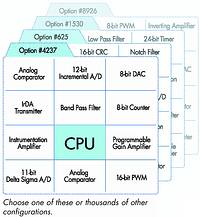
The PSoC microcontroller from Cypress Microsystems enables designers to select from a variety of circuit elements including ADCs, DACs, op-amps, counters, timers, pseudo random generators, analog filters and UARTs that best fit their application, and then control these elements with the popular M8 microcontroller.
Unlike other microcontrollers, PSoC allows design engineers to program a single chip for a variety of functions, and then change functions in system 'on the fly'.

No more design tradeoffs
Designers spend time at the beginning of a project looking for the right processor, and usually have to make many tradeoffs because they can never find the microcontroller that has exactly the peripherals they want. All that is changed with PSoC. The project now starts inside the development tools where one configures the PSoC blocks to the peripheral set that is perfect for the application. Further steps in the configuration process allow one to connect these functions in sequence to create signal chains appropriate to one's application.
With PSoC there are fewer parts to buy, fewer parts to qualify, and the configuration is exactly as needed.
Fewer chips means lower costs
In an example of a 'wireless thermostat' the specifications are: LCD panel readout; Keypad for user input; IR communication back to base.

How PSoC fits this application (see Figure 2):
* Allows one to remove external components.
* Gives all the elements to make signal chains.
* Reduces board size.
* Reduces placement cost.
* Has high-accuracy analog for thermistor measurement.
Standard building blocks for a custom design
PSoC blocks: The analog and digital blocks that support peripheral functions are called PSoC blocks. These blocks are configured via register settings to perform a wide range of functions. The inputs and outputs from each block are also set with register bits. Each of these blocks is designed to support a wide variety of peripheral functions. Each digital PsoC block is an 8-bit-wide resource.
Therefore, creating an 8-bit pulse width modulator (PWM) requires one digital PSoC block. Two or more blocks can be used together to create wider bit width functions. The analog PSoC blocks are designed around an operational amplifier, and include programmable multiplexing and programmable feedback characteristics. There are three types of analog blocks: a continuous time analog block that has a programmable resistor matrix in the feedback path, and two types of switched capacitor blocks, which have switched capacitors in the feedback path.
User modules
Cypress has made the configuration process easy by creating a library of user modules that are pre-created and pre-tested configurations of PSoC blocks to make peripherals. Upon selecting a particular user module, all the bit-level programming is done by the 'PSoC designer' software (the integrated development environment), letting designers focus on their application. A user module also includes Application Program Interface (API) routines to communicate to the user module, and the necessary interrupt handling software.

All the specifications for the user modules are in the PSoC Designer software. A typical digital user module is a UART, and a typical analog user module is a 12-bit incremental ADC. The large number of user modules to choose from can eliminate requirements for external components, and can reduce the overall parts count in a system.
Dynamic reconfiguration for more value
The peripheral set and interconnect are selected by setting register values, but also, they can be changed while PSoC is running, thereby making a completely different custom processor for different states of one's application. This capability is called dynamic reconfiguration. It extends the peripheral capability beyond the number of PSoC blocks on the original PSoC. In every design there are peripherals that are used only occasionally, if at all. The PSoC development software enables one to create the second and subsequent configurations as easily as the first. The software interface that is required to switch between one configuration and another is automatically generated, so managing this change-of-state is as simple as a subroutine call from the application software.
In an example of a 'floating emergency locator beacon' the specifications for the design are: must have several discrete modes of operation; monitors state-of-charge on battery; must perform periodic self-test; Automatically turns on beacon when wet.

PSoC fits this application (see Figure 3) by:
* Using dynamic reconfiguration of user modules for multiple application states.
* Allowing one to choose from many different peripheral combinations.
* Having high-accuracy analog for battery monitoring.
Efficient development tools speed time-to-market
The development process starts inside the PSoC Designer software. This package includes all the tools to create and configure PSoC to meet custom needs. A simple graphical interface allows the developer to select the user modules needed, place them on the hardware PSoC blocks, and interconnect them with each other and the I/Os (see Figure 3). The toolset also includes a C compiler and an in-circuit emulator (ICE) that has full-speed operation, 128 KB of trace memory, and complex breakpoints. Adapters are also available to support emulation on all devices in the PSoC family, and to convert the ICE to a single-socket programmer for every device type.
PSoC Designer software is available for free download from the Cypress MicroSystems website ( www.cypressmicro.com), and the development kit and C compiler are available for purchase from Analog Data Products.
For more information contact Analog Data Products, 011 809 6100, a division of Avnet Kopp.

© Technews Publishing (Pty) Ltd | All Rights Reserved